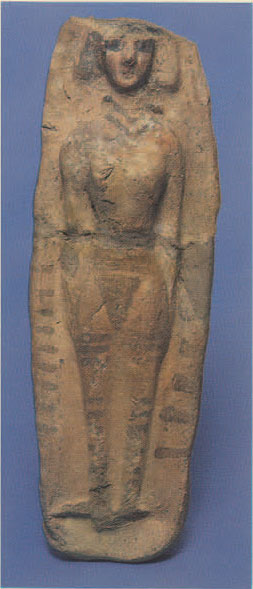A new permanent exhibition on Canaan and Ancient Israel is now open at the University of Pennsylvania Museum. The over 450 objects on display were excavated from Bronze and Iron Age (ca, 3300-550 BCE) occupation levels at five major sites in Israel, Jordan, the West Bank, and Lebanon. This time period has traditionally held particular fascination for researchers because it is the period of the Old Testament or Hebrew Tanak. These later biblical accounts were “concerned with defining the cultural boundaries that separated ancient Israel from her neighbors and predecessors,” writes co-curator Dr. Bruce Routledge, but “archaeological research has shown us that the biblical world was a cosmopolitan one with significant contact and cultural exchange among the region’s ancient peoples.”
All of the pieces seen here come from the great site of Tel Beth Shean, excavated by the University Museum seventy-five years ago. Among the most impressive finds were those from the Late Bronze Age and Early Iron Age, when the site was an Egyptian administrative center and garrison. For the more than 300 years that Egypt ruled Canaan, deities, arts, and technology were intermingled between the two cultures. Those international influences are visible in the ceramic, ivory, and faience representations seen here, which document the sharing of artistic styles from Egypt, the Near East, and Greece during the period when Bronze Age Canaan came to an end and the biblical Iron Age kingdoms of Israel and Judah came into existence.—Ed.
At Beth Shean nearly 50 anthropoid sarcophagi were found in tomb deposits dating to the 12th century, the period of transition from the Bronze to the Iron Age. The massive cylindrical, cigar-shaped “coffins” were built up from long coils of clay. When the clay was leather hard, a circular opening was cut into the upper part to serve as an opening for interring the corpse. Subsequently, a human face and hands were rendered in high relief on the lid.

The faces fall into two types: “naturalistic” and “grotesque.” For the naturalistic type, the most common, a kind of mold-made mask of a human face was applied to the lid by pressing and smoothing the clay on both sides. On the grotesque type, the features were formed by applying bands of clay and working them to shape the highly exaggerated features. Whether the faces are meant to he likenesses is not clear; however, the use of the coffins contrasts with the communal burials more typical at this time, and suggests a certain individuality in death. Such anthropoid sarcophagi appear to be imitations of Egyptian anthropoid clay coffins, and may have been intended for burial of native Egyptian soldiers stationed in the southern Levant, or Canaanites or mercenaries in the service of Egypt.
Five superimposed temples were built and rebuilt at Beth Shean from the 15th to the 11th century BCC These temples were equipped with objects indicating a mixture of Egyptian and Canaanite religious practices, including small faience pieces like the amulet seen here (a), rattles, bowls, and this ivory clapper (b). Hathor was the Egyptian goddess of love and joy, and of turquoise and foreign lands. She was usually represented, as here, with cow’s ears and a spiraling wig.
Above the face on the clapper is a fully extended right hand. Most researchers assume that in Egypt a pair of such objects would have been clapped above the head of celebrants in a dance festival honoring Hathor. In the southern Levant, however, they are rather rare and found singly, so ceremonies honoring Hathor at Beth Shean may not have followed Egyptian practice.
Nude female figurines similar to this one are often found at Late Bronze Age sites in the southern Levant and Egypt. They were made by pressing clay into an open-face mold, so the figure was formed in full relief on a flat-backed plaque that might be modeled to represent a bed. This figure, probably a goddess, may be associated with the fertility cult of the region. Because Canaanite deities were often identified with Egyptian deities, she may be a combination of Hathor, the Egyptian goddess, and one or more of the principle Canaanite goddesses—perhaps Qudushu or Ana or Astarte.
This expressive head, wearing a tall fluted “feather” headdress, was applied to the exterior of a tall cylindrical stand, of which only a fragment of the wall survives. Such pottery stands probably supported bowls used to present food and drink offerings. They were common not only in the southern Levant, but also in Egypt and Mesopotamia during the Bronze Age. Like the female plaque figurines, the cylindrical stands were prevalent in temple contexts and probably had a cultic function.
This rather charming stand in the form of a shrine- or house-model is two-storied. It has two doorways and two windows in the top story, six windows in the lower story. Two figures holding birds, probably doves, stand back to back in the doorways. Because the top is shaped like a ring, it probably served, like the earlier cylindrical stands which continued into this period (see Fig. 5), as a support for a pottery vessel for offerings. Rather elaborate cylinders from Beth Shean of this period incorporate elements that also appear on ritual objects from both Crete and the Near East, including perching birds and writhing snakes.






